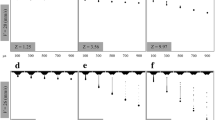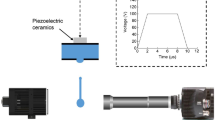Abstract
One of the most important design parameters for the inkjet printing device is the inkjet drop velocity, which changes along the falling path from the ejection out of a nozzle to the impact on a substrate. Therefore, in this study, the droplet velocity of the piezoelectric drop-on-demand inkjet was measured. The nozzle diameter was 70 µm and polyethylene glycol aqueous solution was used as ink. The inkjet droplets were generated within a range from 500 to 10000 Hz of frequencies at a reference piezoelectric input voltage. The successive inkjet droplets were captured by the high-speed camera with 100000 fps, then the inkjet droplet velocities were analyzed visually at each falling location. The velocity change of a drop up to its terminal velocity was calculated theoretically to be compared with the experimental results. This study found that the velocity of the continuously ejected droplets depended on the interval of the droplets, as well as the density and diameter of the droplet which are essential factors of the general velocity change of a falling drop. The inkjet droplets with the long interval can be considered as an independent droplet so that it can follow the terminal velocity curve of the general drop. However, the inkjet droplets with short interval have the higher velocity than the general terminal velocity curve. It is considered that each droplet gets into the wake field of the former droplet so that its drag force can decrease and the velocity can increase.
Similar content being viewed by others
Abbreviations
- A :
-
Area
- C d :
-
Drag coefficient
- d :
-
Diameter
- g:
-
Gravitational acceleration
- m :
-
Mass
- Oh:
-
Ohnesorge number
- Re:
-
Reynolds number
- t :
-
Time
- V :
-
Volume
- v :
-
Velocity
- v T :
-
Terminal velocity
- We:
-
Weber number
- Y :
-
Surface tension
- μ :
-
Dynamic viscosity
- p :
-
Density
References
H. Wijshoff, Manipulating drop formation in piezo acoustic inkjet, International Conference on Digital Printing Technologies, Denver, CO, USA (2006) 79–82.
H. Wijshoff, The dynamics of the piezo inkjet printhead operation, Phys. Rep., 491(4–5) (2010) 77–177.
B. Derby, Inkjet printing of functional and structural materials: Fluid property requirements, feature stability, and resolution, Annual Review of Materials Research, 40(1) (2010) 395–414.
D. Jang, D. Kim and J. Moon, Influence of fluid physical properties on ink-jet printability, Langmuir, 25(5) (2009) 2629–2635.
S. D. Hoath, Fundamentals of Inkjet Printing: The Science of Inkjet and Droplets, Wiley-VCH Verlag GmbH & Co. KGaA, Weinheim, Germany (2016).
P. C. Duineveld, M. M. de Kok, M. Buechel, A. H. Sempel, K. A. H. Mutsaers, P. van de Weijer, I. G. J. Camps, T. J. M. van den Biggelaar, J.-E. J. M. Rubingh and E. I. Haskal, Ink-jet printing of polymer light-emitting devices, Proc. SPIE 4464, Organic Light-Emitting Materials and Devices V (2002) 59–67.
C. D. Stow and M. G. Hadfield, An experimental investigation of fluid flow resulting from the impact of a water drop with an unyielding dry surface, Proceedings of the Royal Society of London. A. Mathematical and Physical Sciences, 373(1755) (1981) 419–441.
W. D. Flower, The terminal velocity of drops, Proceedings of the Physical Society, 40(1) (1927) 167–176.
R. Gunn and G. D. Kinzer, The terminal velocity of fall for water droplets in stagnant air, Journal of Meteorology, 6(4) (1949) 243–248.
A. C. Best, Empirical formulae for the terminal velocity of water drops falling through the atmosphere, Quarterly Journal of the Royal Meteorological Society, 76(329) (1950) 302–311.
G. B. Foote and P. S. Du Toit, Terminal velocity of raindrops aloft, Journal of Applied Meteorology, 8(2) (1969) 249–253.
V. I. Khvorostyanov and J. A. Curry, Terminal velocities of droplets and crystals: power laws with continuous parameters over the size spectrum, Journal of the Atmospheric Sciences, 59(11) (2002) 1872–1884.
C. Yu, P. Hsieh, S. E. Yuter, L. Cheng, C. Tsai, C. Lin and Y. Chen, Measuring droplet fall speed with a high-speed camera: Indoor accuracy and potential outdoor applications, Atmospheric Measurement Techniques, 9(4) (2016) 1755–1766.
J. L. Buzzard and R. M. Nedderman, The drag coefficients of liquid droplets accelerating through air, Chemical Engineering Science, 22(12) (1967) 1577–1586.
R. Clift, J. R. Grace and M. E. Weber, Bubbles, Drops, and Particles, Academic Press, New York (1978).
R. L. C. Flemmer and C. L. Banks, On the drag coefficient of a sphere, Powder Technology, 48(3) (1986) 217–221.
Y. Gim, D. K. Jang, S. H. Choi, G. Kang, B. Seong, D. Byun, D. K. Sohn and H. S. Ko, Experimental study on slippery droplet dynamics using optical correction method, Journal of Mechanical Science and Technology, 32(10) (2018) 4731–4736.
Acknowledgments
This work was supported by the Basic Science Research Program through the National Research Foundation, Korea (2019R1A2C2003176).
Author information
Authors and Affiliations
Corresponding author
Additional information
Recommended by Guest Editor Seongwon Kang and Hyoung-gwon Choi
Seung-Hwan Kang is a Postdoctoral Researcher in Korea Aerospace Research Institute. He received his Ph.D. in Mechanical Engineering from Sungkyunkwan University in 2020. His research interests are numerical analysis of fluid dynamics and heat transfer, and micro-droplet control.
Han Seo Ko is a Professor in School of Mechanical Engineering, Sungkyunkwan University. He received his Ph.D. in Mechanical Engineering in 1998 from Texas A&M University. His research interests are flow control, microfluidics, optical tomography, micro-droplet ejection and heat and mass control.
Rights and permissions
About this article
Cite this article
Kang, SH., Kim, S., Lim, J.W. et al. Study on fall velocity of continuously ejected micro inkjet droplet. J Mech Sci Technol 34, 3311–3315 (2020). https://doi.org/10.1007/s12206-020-0723-1
Received:
Revised:
Accepted:
Published:
Issue Date:
DOI: https://doi.org/10.1007/s12206-020-0723-1




